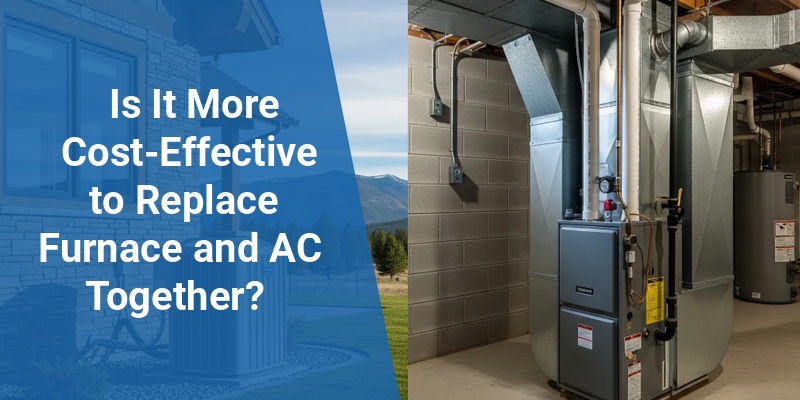Deciding whether to replace a furnace and air conditioner at the same time is a common consideration for homeowners aiming to maximize efficiency and manage expenses. Both systems play crucial roles in maintaining indoor comfort throughout the year, but the timing and strategy behind their replacement can significantly impact initial costs, energy efficiency, and long-term savings. This article explores the financial, operational, and practical aspects of replacing furnace and AC units together versus separately.
| Aspect | Replacing Together | Replacing Separately |
|---|---|---|
| Initial Installation Cost | Higher but combined savings on labor | Lower immediate cost per unit but potentially higher overall |
| Energy Efficiency | Better system compatibility and overall efficiency | Possible inefficiency if units differ in technology |
| System Longevity | Aligned system lifespan reduces unexpected breakdowns | Staggered lifespan may cause frequent servicing |
| Incentives & Rebates | More opportunities for bundled rebates or promotions | Limited to individual unit rebates |
| Disruption | Single downtime period for installation | Multiple disruptions during separate replacements |
Financial Benefits of Replacing Furnace and AC Together
Replacing both furnace and air conditioning units simultaneously can lead to significant cost savings. One of the primary benefits is the reduction in labor costs. HVAC professionals can perform combined installations in a single service call, reducing service fees, time, and logistical challenges. Additionally, some dealers offer bundles or discounts for purchasing both systems at once.
Moreover, homeowners can take advantage of tax credits, manufacturer rebates, and utility incentives that are often available for whole-home system upgrades. These rebates tend to be more substantial when upgrading both heating and cooling systems together, supporting improved energy efficiency and environmental benefits.
Energy Efficiency and System Compatibility
When furnace and AC units are replaced together, the systems can be designed to work optimally as a matched set. Modern HVAC equipment often includes advanced technologies such as variable-speed blowers, smart thermostats, and high Seasonal Energy Efficiency Ratios (SEER). By installing units that complement each other, homeowners benefit from improved energy consumption and better climate control throughout the year.
Separate replacements may lead to mismatched equipment, causing reduced performance and potentially higher energy bills. Over time, the systems could strain against one another due to differing operational qualities, which may shorten lifespan and lead to more frequent repairs.
Installation Considerations and Convenience
Scheduling the installation of both furnace and AC systems at once minimizes homeowner disruption. Replacing these core components often involves electrical work, duct modifications, and system testing. Completing both replacements simultaneously reduces the total time during which the home experiences downtime.
Additionally, a unified installation allows HVAC contractors to ensure ductwork, ventilation, and controls are correctly configured for the new systems, enhancing performance and indoor air quality.
Call 888-906-9139 for Free Local HVAC Quotes – No Obligation, Just Savings!
Comparing Longevity and Maintenance Costs
Older systems are more prone to breakdowns, and when the furnace and air conditioning units differ significantly in age, one may fail sooner, requiring urgent repairs or replacements. Replacing both systems together aligns their operational lifespan, reducing the likelihood of unexpected failures and providing a more predictable maintenance schedule.
Furthermore, newer HVAC systems require less frequent and less costly maintenance due to improved technology and construction.
When Might Replacing Systems Separately Make Sense?
Although combined replacement has many advantages, there are scenarios where replacing furnace or AC units separately could be more appropriate:
- Disparate unit conditions: If one system is relatively new and functioning efficiently while the other is failing, replacing only the faulty unit can save money.
- Budget constraints: Immediate budget limitations may necessitate staggered replacements spread over time.
- Technological upgrades: Homeowners interested in only upgrading heating or cooling technology while delaying the other for strategic reasons.
Summary of Costs and Savings
| Cost Component | Replacing Together | Replacing Separately |
|---|---|---|
| Equipment Price | $7,000 – $12,000 (combined) | $3,500 – $7,000 per unit |
| Labor and Installation | Reduced combined labor costs | Separate labor costs for each installation |
| Energy Bills (Annual) | Lower due to matched systems | Potentially higher with mismatched efficiency |
| Maintenance | More predictable; often less costly | Staggered, may increase overall cost |
| Incentives | Bundled rebates and tax credits | Limited to single unit incentives |
How to Choose the Right Time to Replace Both Systems
Homeowners should assess HVAC system age, current performance, and energy costs to determine the best timing for replacements. Here are key indicators favoring simultaneous replacement:
- Both systems older than 10-15 years.
- Frequent repairs on either system.
- Desire to upgrade to energy-efficient systems.
- Upcoming home renovations affecting HVAC infrastructure.
Consulting with a certified HVAC professional can provide a tailored assessment aligning with home energy needs and budget.
